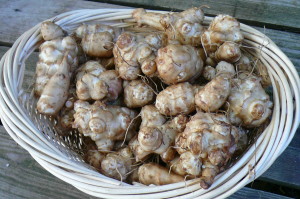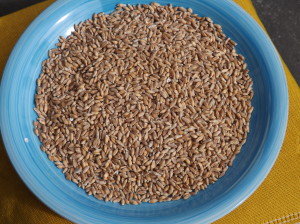Week 15, October 17
Both boxes have: Sunchokes, Russet potatoes, garlic, Lacinato kale, triticale berries, cylinder beets & greens, carrots
The Small box also has: Arugula
The Standard box also has: Baby leeks, Savoy cabbage
Sunchokes
A sunchoke is a tuber, or an underground vegetable, like a cross between a rutabaga and a potato, with the flavor of sunflower seeds and the crunch of water chestnuts. It’s also called a Jerusalem artichoke, even though it is not an artichoke at all, and it has nothing whatsoever to do with Jerusalem. They are closely related to the sunflower. Native Americans were eating sunchokes centuries before the Europeans arrived in the 1500s. In fact, the Europeans thought sunchokes were poisonous at first. Once they got over that, they have enjoyed its nutty flavor in many dishes.
Jerusalem artichokes are easy to prepare. You can cook them just like you would a potato: roast, boil, saute, bake or steam. You can leave the skin on or peel it off. It’s up to you, but make sure you wash them well. The surprising thing about these little roots is that you can also eat them raw. They add a great texture to salads, salsas, marinades and stir-frys, in small pieces or grated.
Sunchokes contain lots of vitamin C and a substance called inulin, a type of starch that can be tolerated by people with diabetes because it breaks down into fructose instead of glucose. This makes sunchokes a good substitute for potatoes for diabetics. Everyone, diabetic or not, can enjoy their great flavor, crunchy texture, and all the good nutrients they provide.
About Triticale Berries
Triticale is a cross between wheat (in Latin Triticum) and rye (Secale) first bred in the late 19th century in Scotland and Sweden. As a rule, triticale combines the yield potential, grain quality, and high protein of wheat with the disease and environmental tolerance of rye. Worldwide, it is grown mostly for forage or fodder, but it is tasty and nutritious and is now widely accepted as a delicious human food. It can be milled into flour and used as a substitute for wheat in breads, pie crusts, cookies, pizza dough and other baked goods, or rolled like oats, for a breakfast cereal.
The berries have a nut-like flavor that, once cooked, can be eaten either sweet (as a breakfast cereal with fruit, honey, yogurt and nuts) or savory (as a side dish, sautéed with onion, garlic , veggies and herbs).
Soak the berries overnight in plenty of water to cut back on your cooking time. Drain and add new water to cover, bring to a boil, then simmer for about 45 minutes. Strain (reserving the liquid for soup) and store in the fridge or freezer.
Add the cooked berries to soups, stews and salads., or mix with cooked rice for a tasty pilaf.



